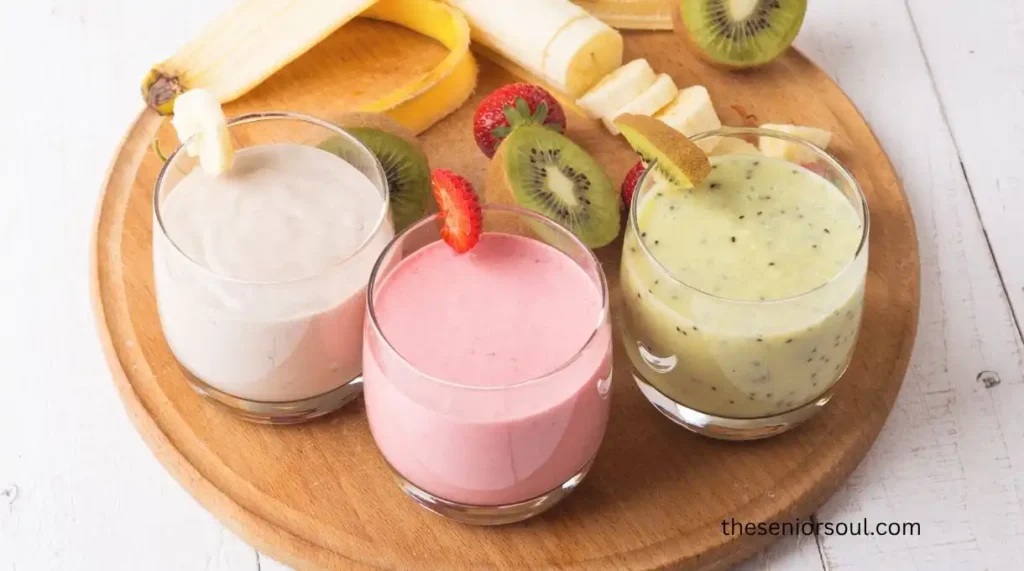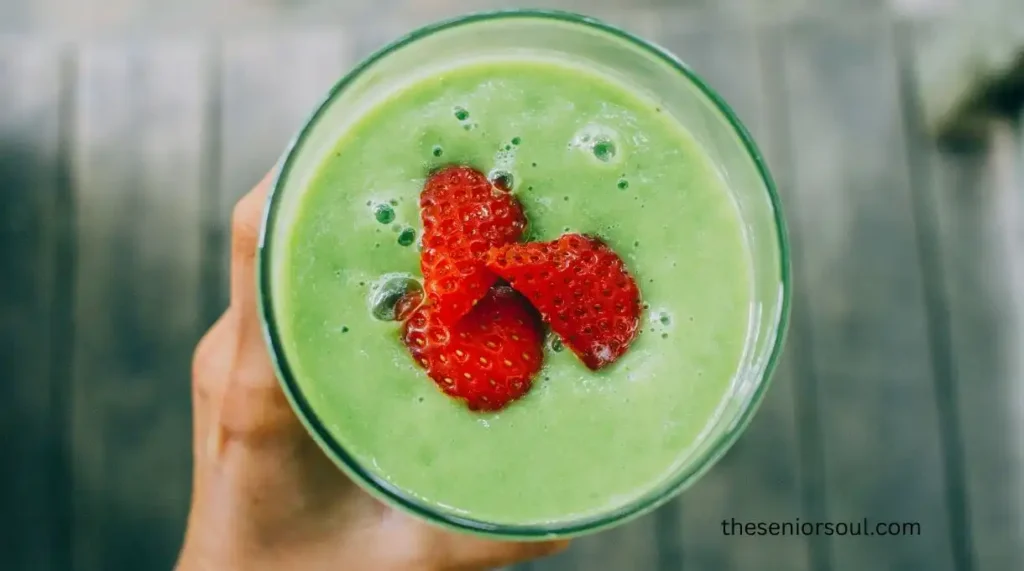Who Needs Must-Know smoothies recipes for seniors for Vitality?

I know how frustrating breakfast can feel when chewing hurts, energy dips, and the scale keeps dropping. Smoothies recipes for seniors bring relief, yet many older friends skip them because sugar overwhelms or protein stays too low. Undernutrition affects at least one in every twelve community-dwelling adults over sixty-five and rises to almost one in three during hospital stays.
Severe dehydration strikes as many as four in ten nursing-home residents, threatening kidneys, mood, and memory. My goal is to walk you through the exact steps, evidence, and five complete smoothie blueprints so you can turn the blender into a daily safety net rather than a sweet treat.
Table of Contents
Ageing Bodies, Shrinking Appetites, Rising Risks
Older bodies need more nutrients per bite precisely when chewing, digestion, and appetite decline. Malnutrition prevalence reaches 8.5 % in the community and up to 28 % in hospitals.pmc.ncbi.nlm.nih.gov Protein requirements climb to at least 1.0–1.2 g per kilogram of body weight, higher than for younger adults, because muscle fibres break down faster after age sixty.
Fiber targets fall to 28 g for men and 22 g for women over fifty-one, yet usual intake stalls at barely half those numbers.health.harvard.edu Daily fluid targets hover near two litres, but water-loss dehydration still strikes up to 38 % of residents in long-term care.
What Happens When Needs Stay Unmet
I have watched clients slide from mild weakness to full frailty as lean tissue melts away. Sarcopenia raises fall risk, slows wound healing, and doubles hospital length of stay.pmc.ncbi.nlm.nih.gov Low fiber magnifies constipation, drives cholesterol up, and fuels blood-sugar swings.
Dehydration elevates serum osmolality, raising mortality risk even after adjustment for illness severity.pmc.ncbi.nlm.nih.gov When chewing difficulty or taste changes block solid meals, the danger compounds. Leaving the problem alone is not neutral; it speeds decline.
Evidence-Based Smoothies Built for Senior Physiology
Why Smoothies Work
- Pureed texture removes chewing pain.
- Liquid base assists the 80 % of hydration that should come from beverages.
- Fortified ingredients deliver protein, fiber, calcium, omega-3s, and carotenoids in one glass.
- Flavor masking lets you slip in spinach, beans, or collagen without large visible servings.
A Norwegian pilot in nursing homes showed that routine high-energy smoothies for seniors helped staff meet calorie and micronutrient goals when traditional snacks failed. Randomized research also links higher fruit-and-vegetable intake with stronger grip and faster walking speeds in older adults.
Core Nutrition Targets for Each Smoothie Recipe for Seniors
| Nutrient | Daily Aim (≥ 65 y) | Per-Smoothie Target | Practical Sources |
|---|---|---|---|
| Protein | 1.0–1.2 g / kg BW | ≥ 20 g | Greek yogurt, whey isolate, silken tofu |
| Fiber | 22 g (F) | 28 g (M) | ≥ 6 g |
| Calcium | 1,200 mg | ≥ 300 mg | Milk, fortified soy, sesame |
| Vitamin D | 15 µg (600 IU) | Partner food with supplement | Fortified dairy or 5 µg added powder |
| Fluid | ≥ 1.6 L (F) | 2.0 L (M) | 250–300 mL |
BW = body weight.

The Five-Step Smoothie Recipes for Seniors Framework
- Base sets hydration and calcium. Use 1 cup milk, fortified soy, or half milk plus half water.
- Protein lifts muscle. Add 1 scoop whey, ¾ cup Greek yogurt, or ½ cup cooked white beans.
- Fiber balances gut and glucose. Blend 2 tablespoons oat bran or 1 tablespoon chia.
- Fruit-veg rainbow supplies antioxidants. Mix 1 cup frozen berries or ½ cup spinach plus ½ cup mango.
- Healthy fat supports calories and absorption. Add 1 tablespoon ground flax or ¼ avocado.
This modular template keeps macronutrients predictable; you swap flavors without losing balance.
Five Complete Smoothies Recipes for Seniors
1. Berry Protein Booster
- Ingredients: 1 cup 2 % milk, ¾ cup Greek yogurt, 1 cup frozen mixed berries, 2 Tbsp oat bran, 1 Tbsp ground flax, pinch cinnamon.
- Macros: 24 g protein, 7 g fiber, 310 mg calcium, 310 kcal.
- Daily Use: Replace mid-morning snack when appetite dips.
2. Green Metabolism Mender
- Ingredients: 1 cup fortified soy milk, ½ cup silken tofu, ½ cup spinach, ½ cup mango cubes, 1 Tbsp chia, 1 tsp fresh ginger.
- Macros: 22 g protein, 8 g fiber, 330 mg calcium, 290 kcal.
- Tip: Ginger cuts vegetal flavor for taste changes common with medications.
3. Oats-&-Peanut Breakfast Shake
- Ingredients: 1 cup oat milk, ¼ cup dry instant oats, 2 Tbsp peanut butter, 1 scoop unflavored whey isolate, ½ banana, 1 tsp cocoa powder.
- Macros: 28 g protein, 6 g fiber, 260 mg calcium, 400 kcal.
- Apply: Blend night before; refrigerate to soften oats, saving time when mornings feel rushed.
4. Citrus Bone-Health Frappe
- Ingredients: 1 cup kefir, juice of ½ orange, ½ cup pineapple chunks, 1 Tbsp sesame seeds, ½ scoop collagen peptides, ice.
- Macros: 20 g protein, 5 g fiber, 350 mg calcium, 250 kcal.
- Why: Kefir introduces probiotics; sesame seeds raise calcium without dairy volume.
5. Savory Tomato-Lentil Sipper
- Ingredients: ¾ cup low-sodium tomato juice, ¼ cup cooked red lentils, ½ cup cucumber, 2 Tbsp Greek yogurt, 1 Tbsp olive oil, pinch cumin.
- Macros: 21 g protein, 6 g fiber, 180 kcal, high lycopene.
- Usage: Serve chilled at lunch for those tired of sweet flavors.
Applying Science to Daily Life
Timing and Distribution
I encourage splitting protein evenly: one smoothie at 10 a.m. and lean animal or legume protein at meals boosts muscle protein synthesis more than loading protein at dinner alone.pmc.ncbi.nlm.nih.gov
Batch Preparation
Freezing smoothie packs (fruit, veg, dry ingredients) in zip bags cuts prep to 60 seconds. Older hands with arthritis appreciate less chopping.
Texture Adjustment
Thinner blends help dysphagia; simply up liquid to 1⅓ cups and strain seeds. Thickening with banana or cooked oats aids individuals who prefer spoonable textures.
Blood-Sugar Management
Choosing berries, beans, and oats keeps glycemic load low. A 2024 double-arm trial showed that adding 20 g extra protein daily did not spike fasting glucose over twelve weeks.
Medication Interaction Checks
Warfarin users should hold spinach below half a cup per serving. Kidney patients with stage 4 disease may need protein capped at 0.8 g/kg; consult the renal dietitian.
Overcoming Common Barriers
- “Smoothies feel cold in winter.” Warm base milk to body temperature before blending; spices like cinnamon help.
- “Sugar bothers my dentures.” Use plain kefir and berries; skip juices or honey.
- “smoothies recipes for seniors taste repetitive.” Rotate herbs (mint, basil), alternate nut butters, or add unsweetened cocoa.
Monitoring Progress
I ask clients to log weight weekly, energy levels daily, and bowel patterns. A three-point improvement in energy after two weeks signals hydration success. Constipation easing after fiber rise shows gut adaptation.
Smoothies Recipes for Seniors as Part of a Balanced Plate
Smoothies work best as a complement, not a replacement, for varied textures. Soft scrambled eggs, stewed vegetables, and whole fruit still train chewing muscles and stimulate saliva.
Conclusion
I have seen worry fade when an older adult finally meets fluid, protein, and fiber goals in one glass. Clear targets, research-backed ratios, and five straightforward smoothies recipes for seniors turn the humble blender into a tool for strength, digestion, hydration, and joy. You now hold the evidence, the framework, and the exact smoothies recipes for seniors. Tomorrow morning, place the milk, yogurt, berries, and oat bran on the counter. Show your body the respect it deserves—blend, sip, and feel steadier every week.
RELATED POSTS
Does Radical Mindset Shift Quotes for Seniors Improve Medication Adherence?
How Does Gratitude Journaling for Seniors Ensure Lasting Life Satisfaction?
100 Powerful Journal Prompts For Spiritual Growth Boost Mindful Living
Frequently Asked Questions FOR smoothies recipes for seniors
What ingredients should older adults avoid in smoothies recipes for seniors?
Older adults should limit added sugars, raw eggs, unpasteurized dairy, and high-oxalate greens like large raw spinach bunches if prone to kidney stones. Avoid grapefruit juice when taking statins or calcium channel blockers. Skip ginseng, green tea extracts, or excessive vitamin powders unless cleared with a pharmacist to prevent interactions.
How can I add protein to smoothies for seniors?
Add protein by blending Greek yogurt, plain kefir, cottage cheese, silken tofu, or a scoop of whey or pea isolate. Cooked white beans and dry milk powder work when budgets tighten. Aim for twenty grams per serving. Spread protein across day evenly to support muscle repair, immune function, and satiety.
Are green smoothies recipes for seniors safe with kidney disease?
Green smoothies suit many seniors with kidney disease when potassium and oxalate are managed. Use half-cup portions of low-potassium greens like kale or chard, pair with berries, and replace banana with frozen cauliflower. Check renal dietitian targets, cap total potassium around two thousand milligrams daily, and avoid high-phosphorus protein powders.
How many smoothies per day are safe for seniors?
Most healthy seniors enjoy one to two balanced smoothies daily without nutrient overload. One eight-to-twelve ounce serving can replace a snack, two may replace breakfast and afternoon tea. Maintain variety by eating solid foods at other meals. Monitor total calories, blood sugar, and hydration carefully; adapt frequency with physician guidance.
Can diabetics over 65 drink fruit smoothies?
Yes, diabetics over sixty-five can drink fruit smoothies when carbohydrates stay controlled. Choose berries, unsweetened almond milk, Greek yogurt, chia seeds, and leafy greens; skip juice, syrups, or tropical fruits. Include protein and fiber to slow absorption. Target fifteen to twenty grams net carbohydrate per serving and track post-blend glucose.
How do I make a high-calorie smoothie for weight gain in seniors?
Boost calories by starting with whole milk or coconut milk, adding peanut butter, avocado, or ground flax, and using oats or cooked lentils for starch. Include protein powder to safeguard muscle while gaining weight. Aim for four hundred calories per glass and drink between meals rather than replacing main courses.
What is the best liquid base for senior smoothies?
The best liquid base depends on tolerance and goals. Cow’s milk supplies protein and calcium; fortified soy offers similar nutrients without lactose; kefir adds probiotics; oat or almond milk lowers calories but needs protein additions. Hydrate first, then choose the base that fits individual digestion, taste, cost, and medication interactions.
How can seniors prevent constipation with smoothies?
Prevent constipation by blending six grams fiber per glass: use oat bran, chia, ground flax, berries, or cooked prunes. Add adequate fluid—one cup liquid plus juicy fruit. Include probiotic yogurt to support gut bacteria. Introduce fiber gradually over a week to reduce gas and encourage regular, comfortable bowel movements daily.
Do smoothies interact with common medications?
Yes, certain smoothie components may alter drug effects. Grapefruit blocks statins; vitamin K-rich spinach changes warfarin dosing; high-fiber psyllium delays thyroid medication absorption. Separate medications from smoothies by two hours when possible, keep green portions modest, and review ingredient list with a pharmacist to adjust nutrients or doses safely, timely.
How can I batch-prep smoothie packs when arthritis limits grip?
Prep smoothie packs by portioning frozen fruit, greens, dry oats, and seeds into zipper bags while sitting at a table to spare wrist strain. Use pre-peeled bananas, pre-washed spinach, lightweight silicone funnels, and an electric jar opener. Store pouches upright in the freezer, then easily empty directly into the blender.






